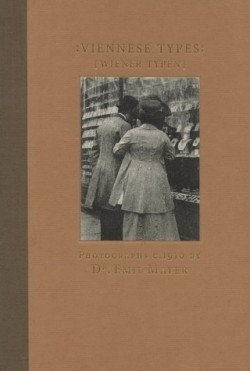Viennese Types
Photographs c. 1910
Frozen in the noiseless still of time, the photographs of Dr. Emil Mayer find
their tongues in the softened cobblestone of Viennese streets and the faded
eyes of market goers to articulate the modest opulence of their humanity.
Viennese Types easily transcends its demure cover and the fabric of its slender
spine, and swells with the emotions of those who read the whispers of history,
nostalgia and art.
These are the nearly forgotten, surviving works of Mayer, a lawyer and Viennese
photographer, who secured much of his fame for his technical contribution to
the art of photography by successfully mastering the photographic “bromoil
process.” He himself called it “the most perfect, flexible and noble
photographic art process,” one which granted him the ability to achieve the
haunting, ethereal quality that so richly characterizes his prints. This
intricate process, described in the book’s introductory essay written by Edward
Rosser, allowed Mayer to manipulate the grain appearance, shading and basic
expression of his images. In this collection of candid street scenes, he
captures the contented air of turn of the century Vienna-of watchful policemen,
stout market proprietors and afternoons lost to newspapers, cigarettes and
cafes. In the plumes which ornately billow above a woman’s hat, a suitor’s
desires and emotions are seen mirrored in imagery, as is the diligence of a
chestnut vendor poised before a gauzy tree-lined street, pausing to return our
gaze.
The obscurity of Mayer’s prints and himself as an artist are attributed to the
hostile acts of the Nazi regime, as his life as a Jew and his art both fell in
the shadow of its criminal oppression. Viennese Types, photographed as Mayer
neared age forty, is one of only two surviving portfolios of Mayer’s work and
has at last met an audience as a published work of art. The foreword by Rudolf
Arnheim and introduction by Rosser are remarkably unintrusive upon the body of
work, successful in acclimatizing expectant eyes to the murky streetscapes and
training ears to the resonant muted bustle of the city.
Sophisticated in its production value, the book boasts the design of Carl Zahn
and over fifty photographic reproductions perfected by the Italian printer
Stamperia Valdonega. With the greatness of artistic vision matched by the
superbness of its presentation, Viennese Types emerges as much a product of its
history, as it is a record of it. Images overflow with the warmth of people,
exuding from the grains of their guileless postures - people unaware of the
harshness of the coming years, as was the photographer who unwittingly
underscored the frailty of humanity from behind an unblinking lens.
Reviewed by
Karen Wyckoff
Disclosure: This article is not an endorsement, but a review. The publisher of this book provided free copies of the book to have their book reviewed by a professional reviewer. No fee was paid by the publisher for this review. Foreword Reviews only recommends books that we love. Foreword Magazine, Inc. is disclosing this in accordance with the Federal Trade Commission’s 16 CFR, Part 255.

